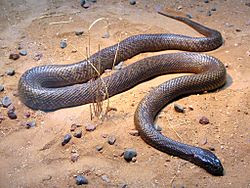PLANT AND ANIMAL TOXIN.. tooot tooot. toooot..
__________________________________________________________
__________________________________________________________
PLANT TOXIN
- Plants contain a large number of biologically active chemicals. Some of these have been found to be extremely useful for treating various human and animal diseases (e.g. digitoxin, colchicines and atropine). However, some plant constituents produce adverse health effects following exposure. The onset of these adverse effects can be quite sudden or take some time to develop.
(Example:)
POISON IVY
 Kingdom: Plantae (plants)
Kingdom: Plantae (plants) -if I were asked to give a plant toxin poison ivy word be first one that would pop-out of my mouth, with that I’m guessing this is the most widely known plant toxin (ha ha). The leaves, stems, and roots of poison ivy contain a resin called URUSHIOL (is the active ingredient in Poison Ivy that causes the rash and irritation). An exposure to this plant would cause an extremely irritating allergic reaction that the doctors usually call it CONTACT DERMATITIS or RHUS DERMATITIS.
DESTROYING ANGEL
BUTTERCUP (RANUNCULUS SPECIES)
-the active ingredient for this plant toxin is GLYCOSIDE (are toxins in which at least one sugar molecule is linked with oxygen to another compound, often nitrogen-based. They become harmful when the sugar molecule is stripped off, as in the process of digestion) that could cause severe irritation.
______________________________________________________________________
______________________________________________________________________
ANIMAL TOXIN
-well basically there are two kinds of animal can produce toxin which are; venomous or poisonous. VENOMOUS animal is caple of producing a toxin a highly developed secretory gland or a group of cells and can deliver toxin by biting or stinging with that an example of this would be;
STONEFISH
-This fish store toxin in their gruesome-looking spines that are designed to protect themselves from a predator. This homely creature will definitely win no beauty prize, but deserves honor and respect for being "THE WORLD’S MOST VENOMOUS FISH."
Another example wound be INLAND TAIPAN
-this snake is considered to be the MOST VENOMOUS land SNAKE in the world. They are also known as small scaled snake and fierce snake. The venom of this is primarily neurotoxic, so bites result in overwhelming effects on the nervous system. This may include in rapid respiratory paralysis, and death.
And another good example of this is BOX JELLYFISH
-"Box jellyfish" or "sea wasp" is also a common name for the notoriously dangerous Chironex fleckeri. The ambiguous but commonly used terms "sea wasp" and "marine stinger" are sometimes used to refer to the more venomous species of box jellyfish. MOST VENOMOUS ANIMAL in the world.
Ok, enough with the examples let’s finish this topic…J next kind of animal toxic would be the POISONOUS animal these animal contains tissues that are in whole part or part toxic and there’s no mechanism to deliver the poison meaning the poisoning takes place by ingesting the animal material particularly the tissue containing the poison. The toxin may be a by-product or a product of metabolism or a chemical that is passed along the food chain. (ex. BARRACUDA, SNAPPER etc.)
Well to make it easier to understand it’s just like: those who eat “BIG FISH” that eats “SMALLER TOXIC FISH” and other MARINE ORGANISM that are toxic such as dinoflagellates will become ill.:)
so much for the plant and animal toxins.:)



















